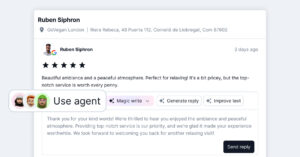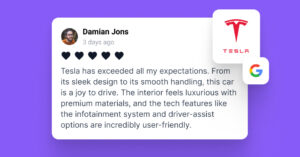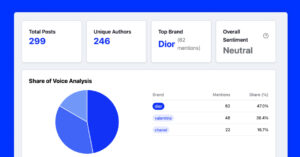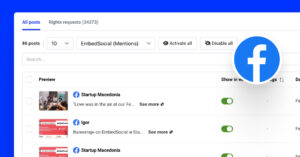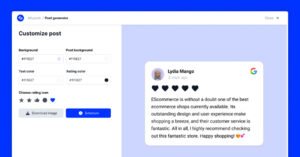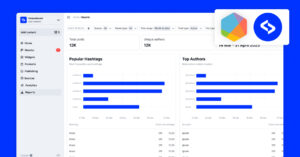Survey analysis is the process of analyzing the customers’ data/feedback gathered from the questionnaires we’ve previously conducted.
Most of the tools for creating surveys provide options to generate the responses but still it takes more than a subset of respondents and percentages neatly put in a table to make sense of the information.
But don’t be overwhelmed; in this blog post, we give you a practical example of how to organize, analyze, and use actionable insights to push your business forward and make all the business’s stakeholders happy.
Let’s dive in.
9 steps to analyse survey results:
- Setup survey form for easier data collection
- Organize the collected survey data
- Use survey data analysis method
- Create personas based on demographics
- Create data-driven content
- Determine the best distribution channels
- Determine social media marketing strategy
- Product improvement
- Predicting future behavior
1. Setup your survey form for easier data collection
To make the whole process of data analysis easier to understand, we will use an example of a straightforward restaurant template.
This online survey mainly contains multiple-choice, closed-ended questions about the food, staff, price, age, and social media platforms customers use to find us.
These types of questions are easier to analyze and can give us a higher response rate.
Nevertheless, the survey includes open-ended questions, which can help us gather more insightful information from the customers.
The survey research should provide us with a better understanding of the needs of our target audience.
However, the use-case examples in this blog post should give you an understanding of the possible data usage gained from any feedback survey, like an example, market research surveys.
2. Organize your survey data
After the data collection process is done, the first step is to export the data from the survey tool into Google Sheets, Excel, or any other statistical analysis app.
If you already have your data in place, you can skip this part and go directly to the survey data analysis.
After we export the survey, the data should look like this:
Next, we should break down the table into more general groups so that we won’t get lost in the list of questions.
Here is one example:
- Demographics
- Marketing: Age | How did you hear about us?
- Staff: Did you feel the staff was welcoming and friendly?
- Food: How would you rate the quality of the food in our restaurant? Did the food arrive on time?
- Menu: Is there anything that you think should be on the menu?
- Price: Did the prices match the quality of your overall experience?
- NPS (Net promoter score): How likely are you to recommend the restaurant to your friends?
- Return: Will you come and visit us again?
After we have the numbers in place, the next step is to calculate the percentage to compare the answers quickly.
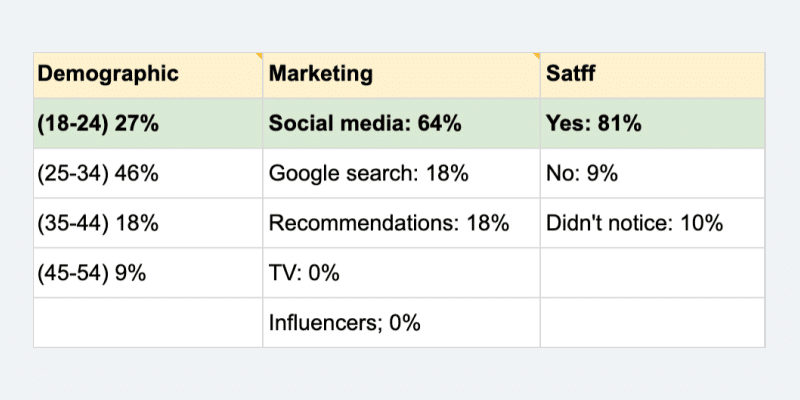
Here is one example of calculating age group percentage:
To determine which age group comes most in our restaurant, we need to divide the total number of people in each age group by the total number of survey answers multiplied by 100.
For that purpose, we will take the 25-34 age group.
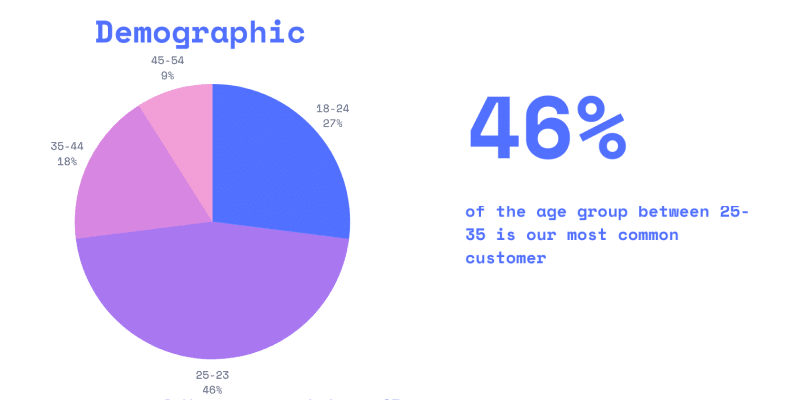
- 25 people aged 25-34 have answered our survey
- The total number of people who answered the survey is 55.
- 25/55×100 = 46%
- 46% of customers who visited our restaurant belong to the 25-34 age group.
3. Use survey data analysis methods
Now it’s time to give some meaning to the quantitative data and qualitative data we have gathered from the survey.
To do that, we will use several easy methods like looking at our top research questions, cross-tabulating and filtering results, and benchmarking the survey results.
Here is what each of those mean:
Top questions
Top survey questions should give us information about the subject/ topic we are most interested in.
For example, if we are interested in improving our marketing and promotional methods, our top research questions would be the ones referring to the marketing part:
How did you hear about us?
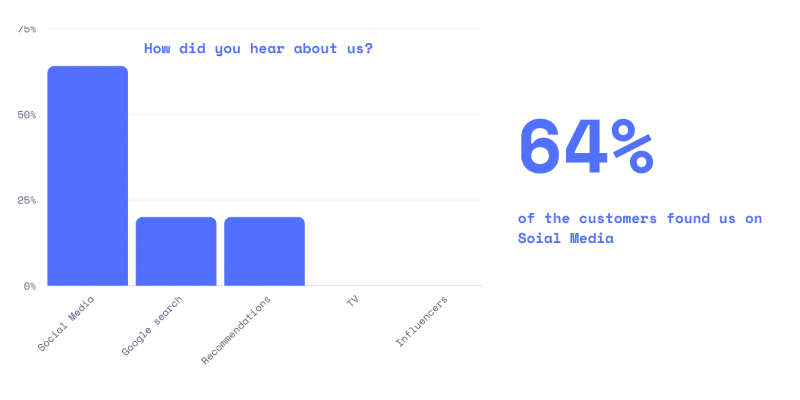
The data that we get from the respondents is evident. 63% of the respondents said that they have heard of the restaurant through social media. 18% of the respondents said that they had found us on Google, and both TV commercials and Influencers have brought us, 0 customers.
So, the top research question is just that, a percentage of the respondents who gave a specific answer to a specific question.
Cross-tabulating and filtering results
Cross-tabulate means comparing results (data sets) between more subgroups from the survey.
Example: We want to compare how the age groups between 18-24 and 25-34 answered the question “How did you hear about us?”

66% of the customers aged 18-24 answered that they have heard of us from social media, 33% responded that they had visited the restaurant after someone recommended the restaurant.
The next group is 25-34-year-olds. 80% answered that they have heard of the restaurant through social media, and 20% responded that they found us on Google.
We can conclude that both age groups mostly “came” from social media, but the age group from 25-34 has a tendency to Google search restaurants as opposed to the age group of 18-24.
Filtering results means that we are focusing only on one subgroup at a time instead of comparing the answers from more subgroups.
For example, we can only analyze the 25-34 age group and explore only their answers to the survey.
Benchmark survey data
Benchmarking means establishing a baseline from where you can compare the data from survey A with the data you will gather with survey B.
Here is an example:
We can take the NPS score data from survey A (How likely will you recommend us to a family or friend) and compare the NPS score with the data from survey B.
The score from our first survey (survey A) is our baseline.
If the data from survey A shows that the NPS score is higher than the data from our second survey, survey B, we need to understand the cause of it.
What are we doing now that is causing people not to recommend us as much as they did before?
We can use different methods for data visualization like bar charts for easier comparison.
—
So far, we’ve gathered a large amount of valuable data. Based on this data, we can draw conclusions, examine how to improve customer satisfaction, and increase value for the business.
Follow the rest of the steps below to check real example of survey-data use-cases: ?
4. Define a buying persona

- Age
- Income
- Interests
- Location
- Buying motivations
Example:
James is a 27-year-old master’s degree student. He is also employed in an IT company.
He comes every Friday night with his friends. He is not married nor has kids. He is very active on social media. He lives nearby the restaurant and earns $94,700 per year.
He likes photography, traveling, and tasting different types of food.
His favorite social media is Instagram, where he shares food stories regularly.
Sample persona example
5. Create data-driven content
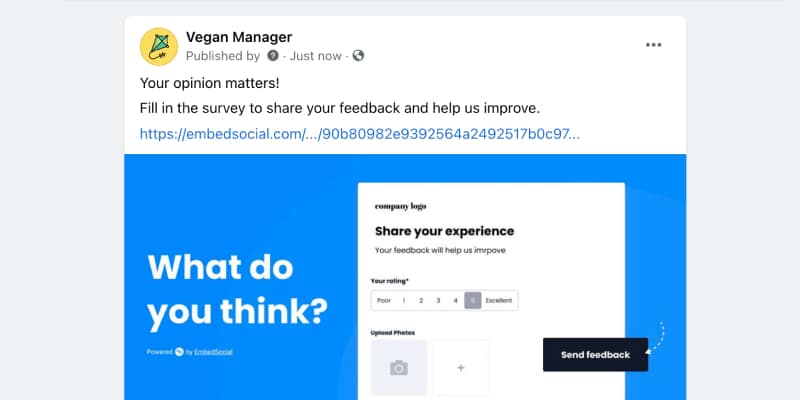
According to the survey responses, our customers are mostly Millennials and Generation Z, which means that the content strategy (when, why, and what to post) should match the consumer habits and personality traits to the people who belong in those age groups.
We can use the survey data to determine the topic, angle, and purpose to create more relatable and engaging content.
Here are few examples of consumer traits that best describe customers between the ages of 18-34.
Research before buying
The millennial generation is notoriously difficult to please, and while many restaurants are trying their best to attract this demographic with expensive renovations or new menu items, the easiest way of making a restaurant appealing for millennials might be as simple as generating reviews. Reposting stories on your social media profiles or website should be a part of your marketing strategy.
Also, if we go back to our survey results, we can see that 33% of people in the age of 18-24 answered that someone recommended your restaurant.
This means that the restaurant is doing a good job and shows us that word-to mouth is a stimulus for people to come to your restaurant.
Afraid of missing out
Another characteristic that distinguishes buyers in these age groups is the fear of missing out.
You can use reviews and testimonials, discounts with countdown timers, or missed opportunities copies.
Visual consumers
Posting videos, images, GIFS, and MEMEs, or even interactive content should be part of your content marketing.
Multi-device consumers.
Everything that you will produce as content needs to be optimized for multiple screen devices.
Language expressions
The copies we write should be for the general public and understandable for everybody.
Tone of voice
Friendly and casual language
Creatives
Most customers are young people, meaning that marketers should also design the creatives (images) to relate to their customers.
6. Determine the best distribution channels

According to the survey results, 63% of survey takers have heard about the restaurant from social media. 18% searched us on Google, 18% visited the restaurant due to someone’s recommendation, and TV commercials and influencers have brought us 0 people.
We can conclude that Social media and Google should be our primary focus for promoting the restaurant and should give up on TV and Influencers.
7. Determine social media marketing strategy
The survey data we’ve gathered can also be applicable in our paid social media marketing strategy for more accurate audience targeting.
Here are few examples of how you can use the data:
- We can use email addresses for retargeting audiences and creating lookalike audiences based on customer lists.
- Adjust the age range of ads, so we can target the right audiences and save time and money for testing based on the demographics data.
- We can use the customer list for notifying the customers of the new items on the menu.
- We can target cold audiences by interest in vegan food. ( Based on the qualitative data from the open-ended questions, most of the respondents would love vegan pizza on the menu)
- By knowing our ideal customer persona, we can properly adjust our budget on Instagram or Facebook.
- Use rating questions to increase the relevance of ad copies.
8. Make improvements based on feedback
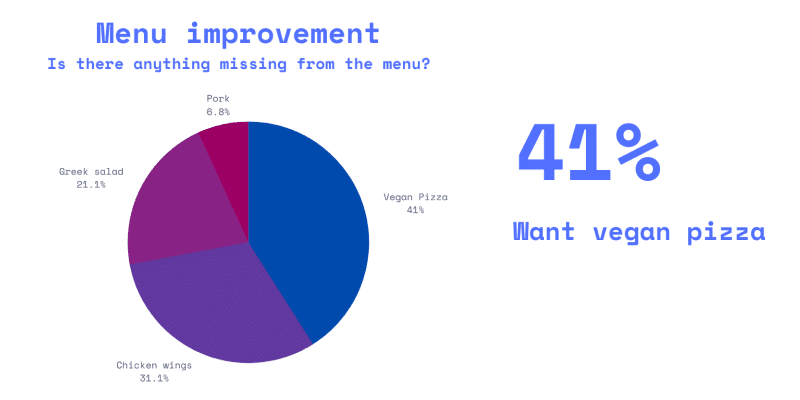
The survey results show us that vegan pizza, chicken wings, and greek salad are foods missing from the menu.
The data tells us that many visitors are vegans, and the restaurant needs to consider vegan options like vegan pizza for its customers.
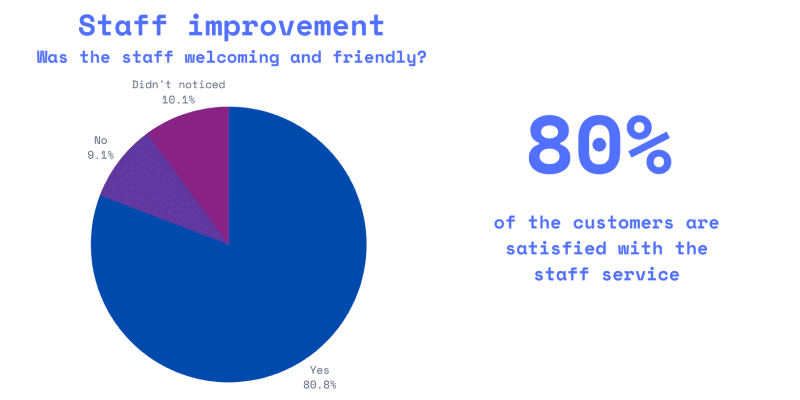
81% of the customers said that the staff was friendly, 9% that it wasn’t, and 10% didn’t notice. This means that the team is doing a good job most of the time when serving the guests.
9. Predicting future behaviors
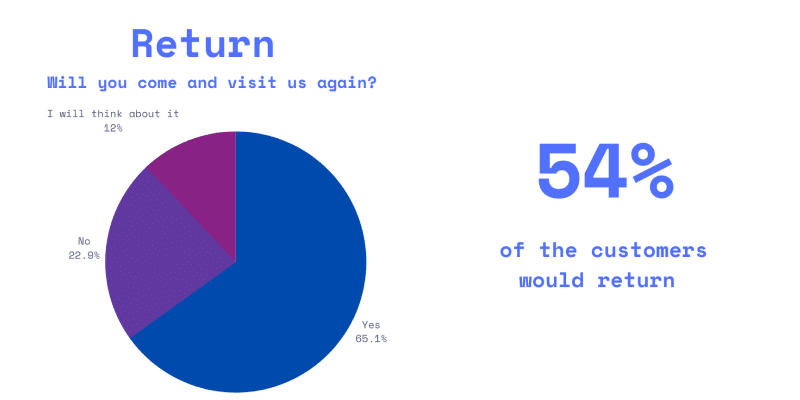
54% of the survey respondents said they would come back, 27% that they don’t know, and 19% said they would not return.
Most customers said they would come back, which is fantastic, but let’s investigate why the customers are unsure of returning to the restaurant using the cross-tabulation method.
27% responded that they don’t know if they would come back to the restaurant.
The logical thing would be to compare these answers to the answers about price, food quality, or staff friendliness as possible things that may influence customer experience.
So here is what we’ve got: ⬇️
60% of people who answered “I don’t know” also said that the price didn’t match the restaurant’s quality. So that may be a reason why someone would think twice before coming to the restaurant.
That being said, we can use this information to predict why and if someone would or wouldn’t come back.
Conclusion
There are endless possibilities for improving your business when your customers are happy to provide feedback. By analyzing customer feedback, companies can better serve their purpose and make fitter customer-centric decisions.
Learning how to analyze and pull out valuable insights is not an easy process; however, once mastered can significantly benefit every aspect of the business.

